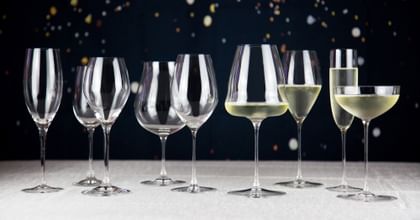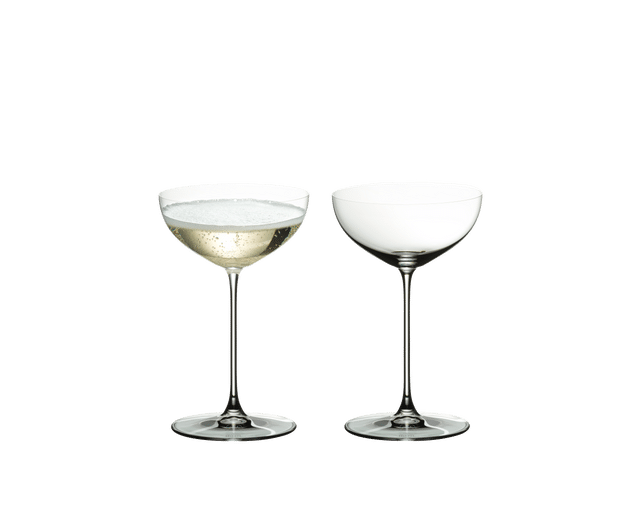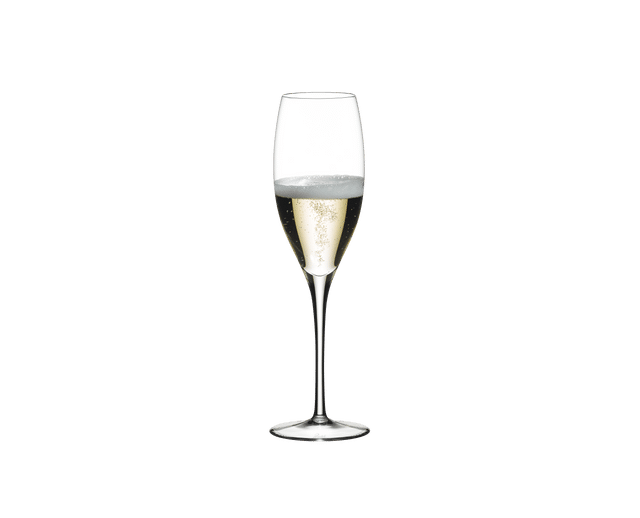Éducation
L'évolution du verre à champagne

Il n'y a pas si longtemps, après avoir ouvert une bouteille de champagne, la plupart d'entre nous attrapions automatiquement nos flûtes. Cependant, au cours des dernières années, la question a été soulevée sur la manière de servir le champagne pour le présenter de la meilleure façon. Nous savons depuis plus de quarante ans que la forme d'un verre a un impact sur votre perception de l'arôme et de la saveur, alors pourquoi continuons-nous à penser différemment pour le champagne ?
La majorité du champagne est composée de trois cépages - Pinot Noir, Chardonnay et Pinot Meunier - et certaines des méthodes de production sont les mêmes entre les vins tranquilles et les vins pétillants. La véritable différence significative réside dans les bulles.
Imaginez que vous ayez acheté une bonne bouteille de vin rouge. L'ouvrirez-vous et le verserez-vous dans la tasse ou le gobelet le plus proche ? Ou bien le décanter, surveiller la température, réfléchir au meilleur verre à utiliser et le savourer au cours d'un repas ?
Nous échangeons volontiers nos verres à pinot noir contre des verres à shiraz lorsque nous passons d'un cépage à l'autre, alors pourquoi laissons-nous les bulles du champagne dominer nos habitudes ? C'est avant tout une question de tradition, et la façon dont l'histoire du champagne a façonné notre vision du récipient dans lequel il doit être servi.

La Coupe
On raconte que la forme de ce verre aurait été inspirée par le sein gauche de Marie-Antoinette. Cependant, l'origine du verre remonte à avant la Reine de France, donc bien que ce soit une bonne histoire, ce n'est pas vrai.
Cependant, la Coupe était populaire pendant son règne, car le champagne produit à l'époque était plus sucré et plus sirupeux. Les bords courts et le bol peu profond de la soucoupe permettaient de tremper facilement son gâteau dedans. Indulgent, certes, mais soyons honnêtes : si vous pouviez tremper votre dessert dans du champagne, ne le feriez-vous pas ?
Le verre a connu un regain de popularité dans les années 1920, puis à nouveau dans les années 1960, avant de redevenir populaire il y a quelques années, au grand désarroi des amateurs de champagne dévoués. En revanche sa forme est totalement inefficace pour exprimer le profil du vin.
La conception ouverte provoque la dispersion presque immédiate des bulles et de l'arôme, et si l'on considère que 70% de notre perception de la saveur provient de l'arôme, vous perdez beaucoup de votre expérience pour le style.
Alors, quelle est la suite après la soucoupe à champagne ?
Il y a environ cinquante ans, le champagne était nettement moins cher qu'aujourd'hui, ce qui le rendait accessible à plus de consommateurs. Bien que cela puisse sembler positif pour les affaires, les maisons de champagne ne pouvaient produire de la qualité qu'à un taux spécifique, et la demande dépassait l'offre.
Ils ont donc fait ce que ferait toute personne intelligente en affaires : ils ont changé le discours autour du champagne. Tout comme l'industrie du diamant nous a convaincus que les diamants sont la seule option lors d'une proposition de mariage, l'industrie du champagne nous a convaincus que c'était quelque chose de spécial, réservé aux célébrations. Soudain, ils ont pu augmenter le prix, le rendant moins accessible.

La Flûte
Désormais considérée comme quelque chose utilisé principalement pour les occasions spéciales, les buveurs de champagne avaient besoin d'un verre qui permettait à la bouteille d'être partagée entre plusieurs personnes. La conception élancée de la flûte la rendait parfaite pour les toasts et fournissait un versement mesuré. Par conséquent, le verre lui-même est maintenant devenu un symbole de célébration. Si vous arrivez chez un ami et que vous voyez des flûtes sur la table, vous savez automatiquement que vous allez passer un bon moment !
Les flûtes ont également l'avantage d'amplifier le perlage. Tous les produits de qualité comprennent une petite égratignure ou une marque à la base qui agite le champagne, l'encourageant à rester pétillant pendant que vous buvez.
Le revers de la médaille est qu'elle ne fournit pas une expression parfaite de l'arôme en raison de son ouverture fine. Même les flûtes en forme de tulipe avec des coupes plus arrondies ne vous offriront pas l'expérience aromatique complète.
En 2013, Riedel a commencé à organiser des ateliers sensoriels pour trouver la meilleure forme de verre pour l'équilibre et l'expression du champagne. Nous avons découvert ce que nous avons longtemps soupçonné : le meilleur verre pour boire du champagne est un verre à vin.
Cela transforme le champagne en quelque chose qui n'est pas seulement réservé aux toasts, mais qui mérite d'être savouré et apprécié. De nos ateliers, nous avons déterminé deux formes gagnantes en fonction du style de champagne.

Le Verre
Un grand verre à vin blanc en forme de tulipe convient mieux aux champagnes plus légers comme le Blanc de Blanc, principalement composé de cépage Chardonnay. Sa taille modeste permet de développer les arômes sans les écraser, en particulier dans les champagnes millésimés où le temps a permis aux caractéristiques de devenir plus complexes.
Pour sublimer les champagnes rosés plus opulents, principalement dérivés des raisins Pinot Noir et Pinot Meunier, le bol du Pinot Noir du Nouveau Monde est imbattable. Il a surpassé les flûtes de loin pour montrer une profondeur de caractère impressionnante.
Notre série RIEDEL Veritas est la première au monde à proposer un verre (pas une flûte) spécialement conçu pour boire du champagne, comme vous le feriez avec un vin tranquille. Le verre à champagne RIEDEL Veritas présente un bol en forme d'œuf courbé avec une petite ouverture pour mettre en valeur l'arôme.
Nous avons organisé des comparaisons flûte contre verre de tous les jours, et chaque participant est toujours étonné de la différence que cela fait. En conséquence, toutes les nouvelles collection de Riedel sont développées avec cette forme de bol pour le Champagne au lieu d'une flûte.
Comme le dit Maximilian J. Riedel, 11e génération : "Le champagne est un vin et mérite d'être traité comme tel. Que vous appréciez un Blanc de Blancs ou une Cuvée, notre verre à champagne permet aux arômes du champagne de se déployer d'une manière qui n'est pas possible avec une flûte étroite."
Qu'est-ce que tout cela signifie ?
Alors que les deux côtés du débat continuent d'être fortement discutés, Dom Pérignon aurait été le premier à adopter la flûte comme récipient désigné pour le champagne, disant qu'il aimait pouvoir "observer la danse des atomes pétillants". D'un autre côté, Olivier Krug, directeur actuel de Krug et arrière-arrière-arrière-petit-fils du fondateur, est catégorique : "Un grand champagne ne peut pas offrir son expression la plus complète dans un verre étroit".
Le meilleur verre à champagne pour vous dépend de la façon et du moment où vous appréciez le champagne, et des styles que vous aimez boire. Bien que nous ne recommanderions pas de boire du champagne millésimé dans une tasse en plastique, vous pourriez être un traditionaliste qui ne peut pas passer outre la flûte classique, ou peut-être que vous aimez être à la pointe et boire du champagne dans vos verres sans pied O Tumblers.
Ou sinon faites une rapide comparaison de verres la prochaine fois que vous ouvrirez quelque chose de spécial. Notre seul avertissement : ne le faites pas en grand nombre, car une fois que vous aurez bu du champagne dans un verre à vin, vous ne voudrez peut-être pas le partager !
Lieux